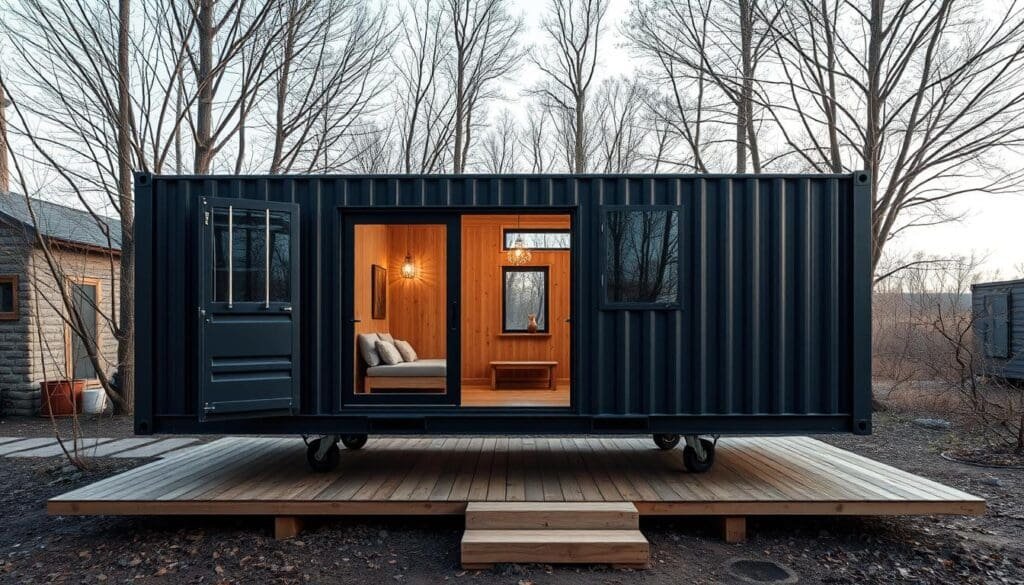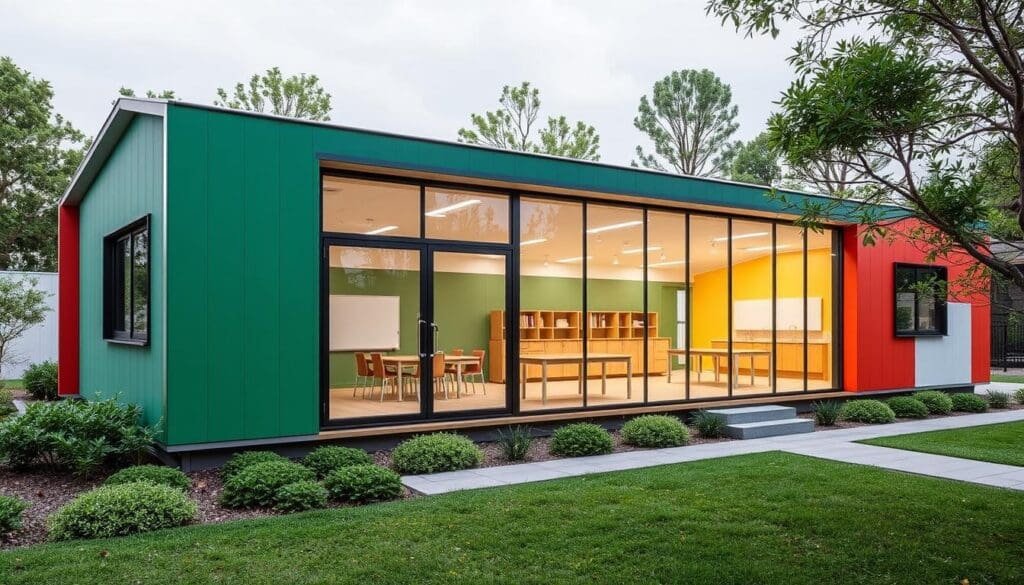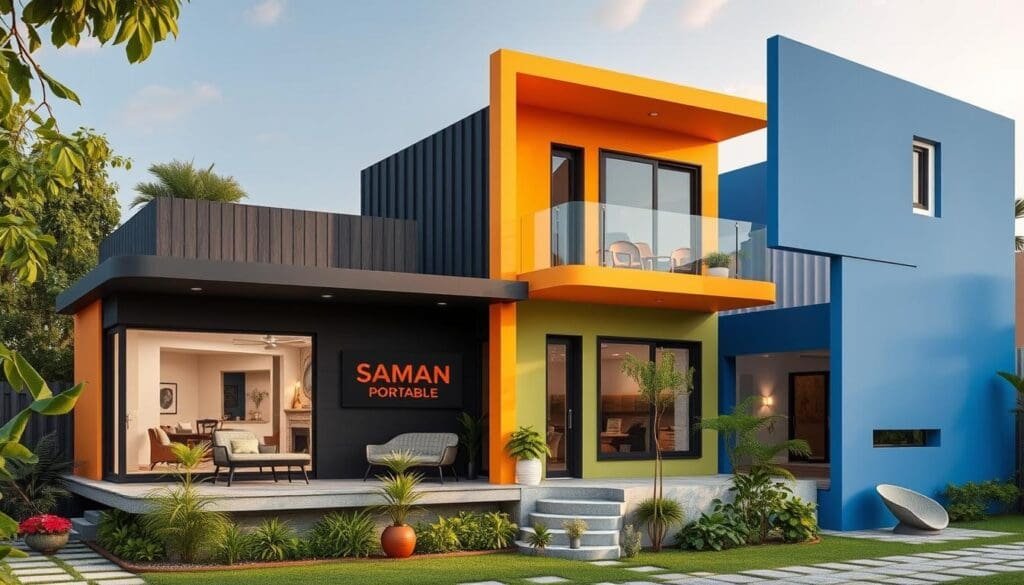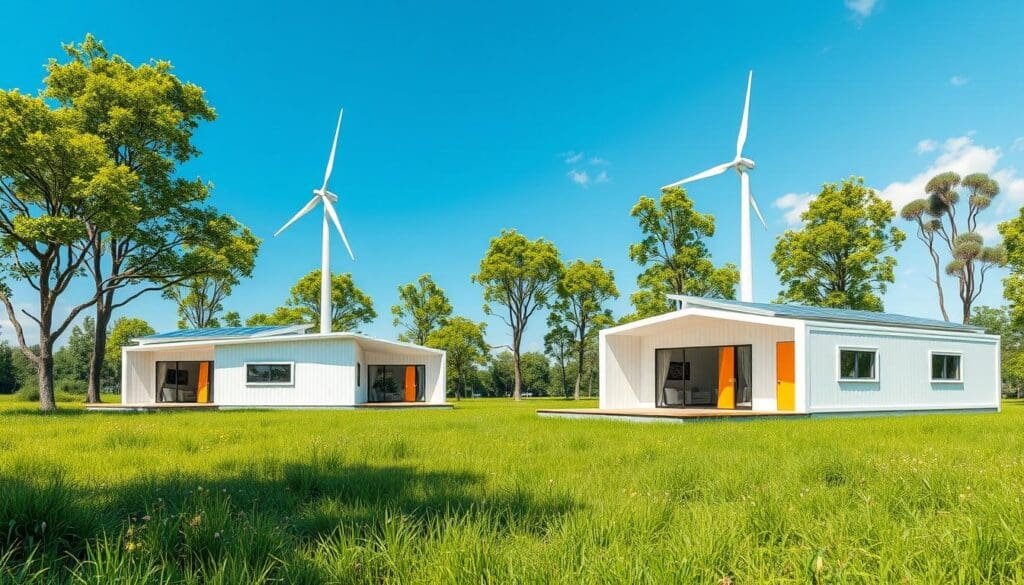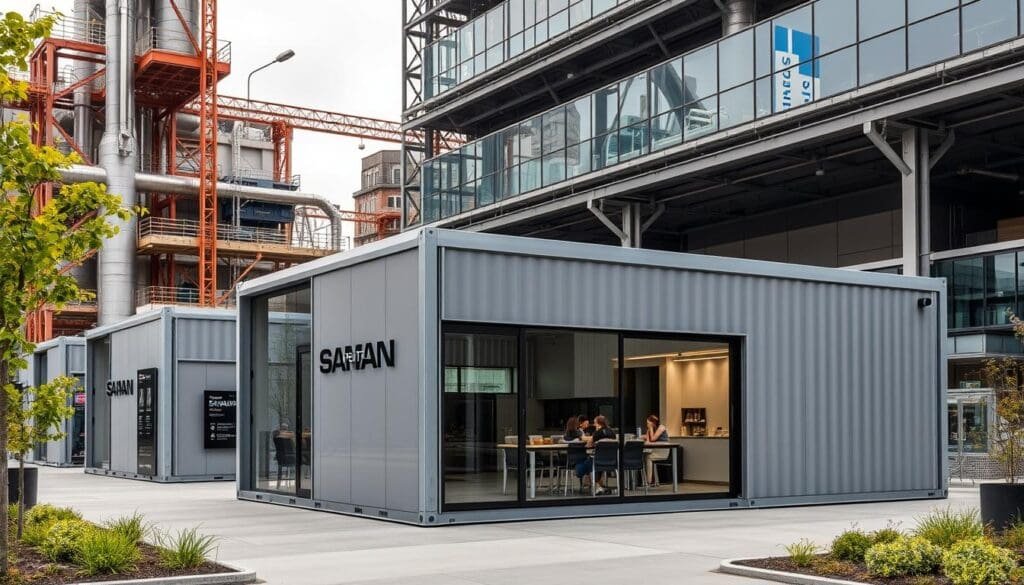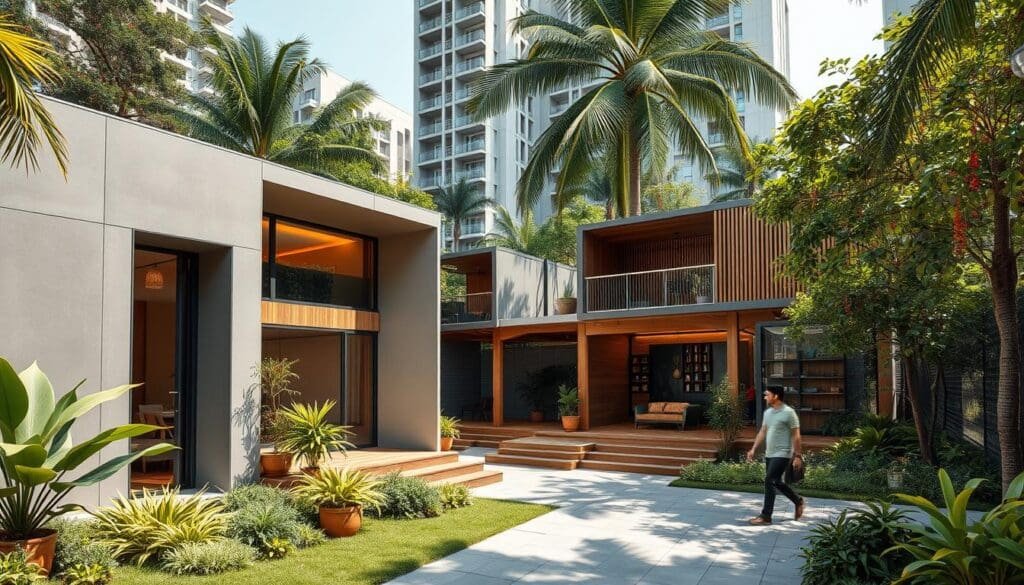Sustainable Construction: How Container Offices Are Revolutionizing Modern Workspaces
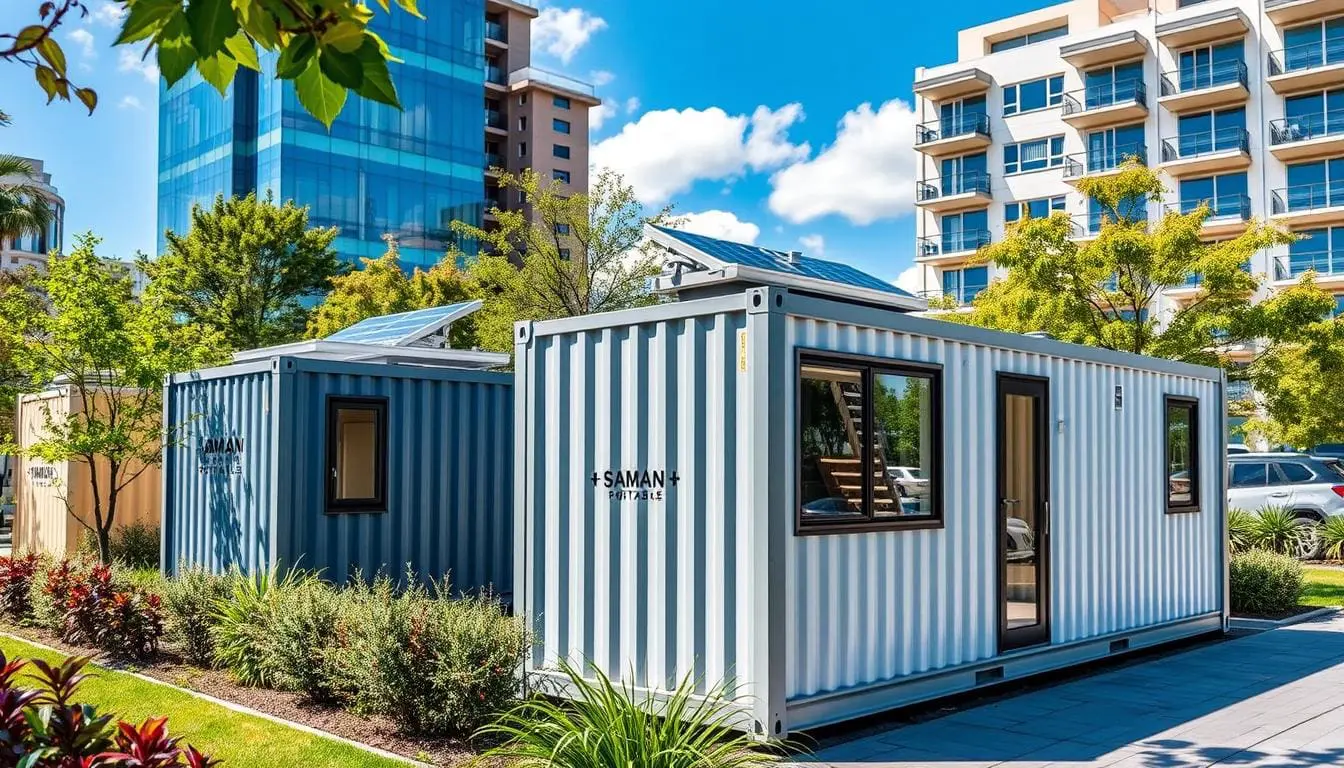
Shipping containers, once used only for shipping, are now changing office design. A huge 85% of them are being used as eco-friendly workspaces. This move cuts down on the need for traditional building materials and lowers carbon emissions.
Container offices are cheaper and faster to build than regular buildings. They also offer great flexibility and customization. This makes them perfect for businesses that need temporary or remote workspaces.
Container offices are also key in sustainable construction. By using shipping containers, businesses can cut down on waste and save natural resources. This approach is setting new standards for green building in the commercial world.
Key Takeaways
- Container offices significantly reduce the demand for traditional construction materials, lowering the carbon footprint.
- These modular units are more cost-effective and quicker to construct compared to traditional buildings.
- The mobility of container offices allows for easy relocation, making them ideal for temporary or remote projects.
- Businesses can reduce their environmental impact and align with green building initiatives through container office solutions.
- Container offices offer customizable layouts, enabling businesses to create unique workspaces tailored to their needs.
Understanding the Evolution of Container Office Spaces
The evolution of container offices has turned shipping containers into modern, green workplaces. This change marks a big shift in how companies view office spaces. Container offices are both functional and eco-friendly, using old structures to cut down on waste and encourage recycling.
From Shipping Containers to Modern Workplaces
Shipping containers used to be just for moving goods and storing items. Now, they serve as flexible office spaces. This new use of old structures is a smart and affordable choice for businesses looking for sustainable office solutions. Converting containers is much faster than building from scratch, helping companies set up offices quickly.
The Rise of Sustainable Office Solutions
- Container offices offer a green alternative to traditional buildings by reusing old shipping containers, reducing landfill waste.
- Using eco-friendly insulation like sheep’s wool and recycled cotton helps keep container offices cool or warm, saving energy.
- Adding solar panels and other green energy sources makes container office workplaces even more sustainable.
More and more businesses are choosing container offices because they care about the environment. These converted structures are a smart, affordable, and flexible option for companies wanting green workspaces.

The Economic Benefits of Container Office Solutions
For businesses, finding cost-effective office solutions is key. Container offices are a big help here. They offer many economic benefits, making them great for startups, temporary needs, and fast-growing companies.
Container offices are cheaper to start with than traditional offices. Turning a shipping container into a workspace is less expensive. Plus, their modular design means they can be set up quickly, saving on labor costs.
The steel structure of shipping containers also saves money. It means less need for extra materials and support. Plus, steel lasts a long time, which means lower maintenance costs later on.
- Container offices average about 320 square feet, similar to a small office suite.
- Their modular design lets you customize them easily. You can stack or place them side by side for different layouts.
- These solutions work well for many industries, like tech, construction, retail, and food services.
Container offices are great for businesses that need to be flexible. They’re perfect for construction, retail, and food services at events or different locations. This flexibility helps businesses adapt to changing needs and market demands.
Container offices also have energy-saving features like insulation and ventilation systems. This means they use less energy and have a smaller carbon footprint. Using old shipping containers also cuts down on waste and environmental harm.
In short, container offices offer many economic benefits. They’re cheaper to start with, save on construction costs, and are easy to move and adapt. They’re a smart choice for businesses looking for cost-effective office spaces, affordable workplace solutions, and to reduce their environmental impact.

Sustainable Construction: A New Era in Commercial Architecture
Container offices mark a big change in sustainable commercial building. They focus on saving resources and using energy wisely. By using old shipping containers, they cut down on waste and need for new materials.
Environmental Impact and Resource Conservation
The building industry is a big source of carbon emissions. This makes saving the planet very important. Companies like Skidmore, Owings & Merrill (SOM) are leading the way with green buildings.
Container offices fit right into this trend. They help reduce harm to the environment with smart designs.
Energy Efficiency in Container Offices
Container offices use the latest green tech to save energy. They use smart ventilation and natural materials to cut down on energy use. This not only saves money but also helps the planet.
Waste Reduction Strategies
Using old shipping containers is key to sustainable building. It cuts down on waste and saves resources. Plus, these offices can be taken apart and used again, showing a commitment to the environment.
Container offices are starting a new chapter in building. They show that being green is possible and important. By focusing on saving resources and reducing waste, they lead the way in eco-friendly workspaces.

Customization Options for Container Offices
Container offices stand out because of their amazing customization options. They let businesses design their workspaces exactly how they want. This means everything from open layouts to private work areas is possible.
One big plus of container offices is how they can grow with your business. Companies can start with a single 20-foot container and add more as they need. This way, they can keep their workspace looking good and working well, even as they get bigger.
Container offices aren’t just about the layout. You can also change the look and feel inside. With lots of insulation and electrical options, you can make your office comfy and energy-saving. It can really show off your brand and help your team work better.
Container offices are great for any business, big or small. They offer a unique and customizable workspace that can really make your company stand out. By using these flexible structures, businesses can create workspaces that are truly special.

Container offices offer endless choices for layout and design. By using this new way of designing offices, businesses can boost productivity and teamwork. They can also express their brand in a big way in their portable office cabins.
Design Innovation in Container Office Spaces
Innovative office design is changing how we see workspaces today. The rise of container offices brings a new era of dynamic and useful work areas. These spaces mix modern workspace aesthetics with innovative office design and functional office layouts. They create places that inspire work and teamwork.
Modern Aesthetics and Functionality
Container offices redefine what a workplace can be. They combine industrial style with modern design. Designers turn shipping containers into bright, innovative spaces that care for the environment.
These offices have sleek glass walls and special décor. They meet the needs of modern businesses. They show how beauty and function can go hand in hand.
Space Planning and Layout Solutions
- Efficient space use: Container offices use smart space planning to make the most of small areas. They create functional office layouts that help teams work better together.
- Modular design: The way containers are built makes it easy to change and grow spaces. Companies can adjust their offices as they grow.
- Multifunctional zones: Container office designs have spaces that do many things. They have meeting rooms, areas for breaks, and places for everyone to work together, all in a small space.
Designers are pushing the limits of innovative office design with container architecture. They create spaces that spark creativity, encourage teamwork, and are good for the planet.

| Feature | Benefit |
|---|---|
| Efficient space utilization | Maximizes the use of limited areas, creating functional office layouts that promote productivity and collaboration. |
| Modular design | Allows for seamless scalability and adaptability, enabling companies to reconfigure their innovative office design as their needs evolve. |
| Multifunctional zones | Incorporates versatile spaces that serve multiple purposes, such as meeting rooms, breakout areas, and communal workspaces, all within a compact footprint. |
The Mobility Advantage of Portable Office Cabins
Portable office cabins offer unmatched mobility. They let businesses change with the market without being tied down. This is key for companies in fast-changing markets or needing temporary spaces.
Container offices can move and set up quickly. They can be ready in days, half the time of building with bricks. This fast setup helps businesses quickly start in new places, grab new chances, and keep working smoothly.
Portable office cabins also help the environment. They’re built with green materials, making no bad emissions. Plus, the leftover materials can be reused or recycled, cutting down on waste. They’re a smart choice for businesses looking to save money, last long, and meet changing needs.
| Feature | Benefit |
|---|---|
| Rapid deployment | Prefabricated portable offices can be constructed in around 50% less time than traditional brick and mortar construction. |
| Sustainable materials | Portable office cabins are made of eco-friendly materials, causing no harmful emissions during manufacturing and assembly. |
| Ease of relocation | Portable office structures can be easily transported and set up in various accessible locations, unlike permanent constructions. |
| Cost-effectiveness | Portable office cabins are a more affordable option compared to the rapidly rising costs of brick and mortar construction. |
The mobility of portable office cabins lets businesses grow and change easily. They can create green workspaces that fit their plans. By using these mobile solutions, companies can lead in the fast-changing business world.

Container Offices vs Traditional Construction
The construction industry has seen a big change with container offices. They offer big advantages over traditional building methods. By looking at cost and time, container offices are a big win for modern workspaces.
Cost Comparison Analysis
Container offices need less money upfront and cost less to build because they’re made before. Traditional single-story offices cost between $238 and $286 per square foot. But, container offices are just over $100 per square foot, saving a lot of money.
The global market for modifying shipping containers was $85.3 billion in 2022. It’s expected to hit $147 billion by 2030. This shows more people are seeing the value and demand for these offices.
Construction Timeline Benefits
Building a container office is much faster than traditional methods. A container office can be ready in weeks, while traditional ones take months or even years. This quick setup is great for businesses that need to act fast.
Container offices also last over 20 years, making them a smart, long-term choice. They’re durable and cost-effective over time.
| Metric | Container Offices | Traditional Construction |
|---|---|---|
| Construction Cost per sq. ft. | $100+ | $238 – $286 |
| Construction Timeline | 6-8 weeks | 6-16 months |
| Lifespan | 20+ years | Varies |
| Sustainability | Eco-friendly, reduced waste | Depends on design and materials |
Container offices are a smart choice for businesses looking to save money and time. They offer lower costs, faster setup, and long-lasting quality. This makes them a big change in the world of commercial construction.

Environmental Impact and Sustainability Features
Container offices are great for the environment. They use eco-friendly and sustainable features. By turning old shipping containers into offices, they save a lot of resources and reduce waste.
These offices often have solar panels and systems to collect rainwater. They also use insulation that saves energy. This makes them a key part of green building practices.
Using recycled materials and being easy to move or reuse, container offices are perfect for green businesses. They show a strong commitment to the environment. This meets the growing need for eco-friendly portable offices and sustainable buildings.
| Sustainability Metric | Conventional Construction | Container Offices |
|---|---|---|
| Energy Consumption | 36% of global energy use | Reduced through renewable energy and energy-efficient design |
| CO2 Emissions | 40% of total emissions | Significantly lower carbon footprint |
| Waste Generation | Up to 40% of solid waste | Minimized through modular and prefabricated construction |
| Raw Material Consumption | 30% of global raw materials | Reduced by repurposing shipping containers |
Choosing container offices shows a business cares about the planet. It also offers cost savings, flexibility, and mobility. It’s a win-win for both the environment and the business.

Adapting Container Offices for Different Business Needs
Container offices are perfect for many business needs. They can grow or shrink as needed. This makes them great for businesses that change size or need different spaces.
Scalability Options
Container offices can grow or change as your business does. You can start small and add more containers as you grow. This way, your office stays useful and efficient, no matter how big or small your business is.
Multi-Purpose Usage Solutions
Container offices can be more than just offices. They can become meeting rooms, creative studios, or even event spaces. This makes them very useful for different needs.
Using container offices, businesses can create spaces that change with their needs. This smart design helps companies use their space well. It makes workspaces that can grow or change as needed.

| Feature | Benefit |
|---|---|
| Modular Design | Easy expansion or reconfiguration to accommodate changing business needs |
| Multi-Purpose Usage | Versatile spaces for various operational requirements, from offices to event venues |
| Sustainable Solutions | Eco-friendly design and reduced environmental impact compared to traditional construction |
| Cost-Effectiveness | Lower initial investment and ongoing operational expenses |
Technology Integration in Container Workspaces
Container offices are becoming more popular and are now using advanced technologies. These smart workspaces meet the needs of today’s businesses. They are turning into tech-enabled spaces.
Container offices are known for being compact and adaptable. This means they need creative solutions to make the most of their space. They use smart lighting and climate control to improve comfort and efficiency.
These offices also focus on communication. They have fast internet, Wi-Fi, and video conferencing tools. This helps employees stay connected and work well, even in small spaces.
Container offices are leading the way in smart, efficient workspaces. They use smart office solutions and tech-enabled workspaces. This makes them appealing to tech-savvy workers and boosts productivity.
| Feature | Benefit |
|---|---|
| Smart Lighting Systems | Automated adjustments based on occupancy and natural light levels for optimal energy efficiency and user comfort |
| Integrated Climate Control | Automated temperature and humidity regulation for a consistently comfortable workspace |
| High-Speed Connectivity | Reliable internet and communication infrastructure for seamless collaboration and remote work capabilities |
| Multifunctional Furniture | Space-saving solutions with built-in storage, power outlets, and technology integration |
The need for new, sustainable office solutions is growing. The use of office container technology in container workspaces is changing the future of work.
Material Selection and Durability Factors
Choosing the right materials is key to building strong and lasting office spaces. Container offices are made from durable office materials like steel. This makes them resistant to weather and long-lasting. These weather-resistant containers can handle tough weather, keeping your workplace safe and functional for years.
Weather Resistance Features
Container offices are built to last, thanks to special coatings and treatments. They can handle everything from strong sunlight and heavy rain to extreme temperatures. This keeps them looking good and working well for a long time.
Longevity Considerations
Container offices are known for their long life. Made from durable office materials, they can last decades with little upkeep. This makes them a better choice than traditional buildings that need constant repairs. They save money and are better for the environment over time.
| Material Attribute | Benefit for Container Offices |
|---|---|
| Corrosion Resistance | Protects against weathering and environmental damage |
| Structural Integrity | Ensures stability and durability over the long term |
| Thermal Efficiency | Improves energy performance and reduces operational costs |
| Recycled Content | Promotes sustainability and a circular economy |
Creating Collaborative Spaces in Container Offices
Shipping container offices have changed the modern workspace. They offer new ways to work together and support teamwork. These spaces can be set up for open collaboration or private work areas.
At the core of container offices is a focus on being green. They use solar panels, collect rainwater, and have green roofs. This not only helps the environment but also makes a beautiful and motivating place to work.
Keeping the office tidy is key. Container offices have built-in storage like shelves and drawers. This helps keep everything organized and work flowing smoothly.
Creating spaces for teamwork in container offices needs careful thought. Using colors, natural materials, and company logos can spark creativity. Adding outdoor spots for relaxation and socializing helps teams bond and share ideas.
Today’s offices need good internet and tech, and container offices are no different. They have fast internet and smart tech for easy communication. This helps teams work together, whether they’re in the office or not.
Container offices can grow with your business. They can change as your team does. This makes it easy to adjust your space to meet your needs.
Designing a container office well takes planning and focus. You need to think about space, budget, and timeline. Working with experts like Coast Containers ensures your office is a success. It becomes a place where teamwork and creativity thrive.
Climate Control and Comfort Solutions
Effective office climate control is key in container offices for comfort all year. Advanced insulation technologies like spray foam and thermal barriers keep temperatures right. Ventilation systems are also smartly integrated for air flow and quality.
These solutions boost comfort and save energy, cutting down on heating and cooling costs. For example, ENERGY STAR central air conditioners use 8% less energy than others. Smart thermostats can also save up to 10% on heating and cooling costs each year.
Insulation Technologies
Good insulation is vital for insulated container offices to keep temperatures comfy. High-performance insulation materials, like spray foam and thermal barriers, help manage heat. This means less energy needed for heating and cooling.
Ventilation Systems
Ventilation systems are key in container office climate control. They ensure good air flow and quality, making work environments healthy and productive. It’s important to upgrade the furnace and blower motor if your air conditioning unit is over 15 years old.
By using top-notch insulation technologies and ventilation systems, SAMAN Portable Office Solutions makes sure their container offices are comfy. They also help save energy and support sustainability.
Safety and Compliance Standards
Container office spaces must follow strict safety and compliance rules. They need to meet building codes, fire safety, and accessibility standards. This ensures the safety of everyone inside and follows the law.
Changes to the structure might be needed to fit local laws and safety standards. It’s important to have the right electrical, plumbing, and HVAC systems. Not following these rules can put people’s safety at risk and harm the company’s reputation.
The Clean Water Act in the United States requires construction to follow water quality rules. It also demands the use of best practices to avoid pollution in water bodies. The Clean Air Act also plays a role, controlling air emissions from construction to protect health and the environment.
Using sustainable materials in construction can help save resources and reduce pollution. New technologies like Building Information Modeling (BIM) and remote sensing help monitor the environment during building. They can spot and fix any problems early on.
| Compliance Area | Regulations and Standards |
|---|---|
| Safety |
|
| Building Codes |
|
| Environmental Regulations |
|
Following these safety and compliance rules helps container office providers keep their workers safe. It also builds trust and credibility in the industry. Staying committed to these standards is key for the success and sustainability of these unique workspaces.
Future Trends in Container Office Design
The world is changing fast, and so is container office design. New technologies and green innovations are leading the way. They aim to make workspaces more efficient, eco-friendly, and tailored to business needs.
Embracing Emerging Technologies
Internet of Things (IoT) devices will change how container offices work. Smart sensors and automated systems will help save energy and make work smoother. Augmented reality (AR) will also change design, making it easier to plan and customize office spaces.
Sustainability Innovations
Sustainability is key in future container office design. Goals include net-zero energy designs and using renewable energy like solar and wind. Circular economy principles will also reduce waste, making offices more eco-friendly.
These trends show a focus on innovative workspace designs and sustainable office innovations. By using new tech and green practices, the container office industry is set to shape the future of workspaces.
Conclusion
Container offices are changing how we design workplaces. They offer a green, flexible, and affordable option for businesses. They are a great choice for those looking for a modern, eco-friendly office.
The need for adaptable and green workspaces is growing. Container offices are becoming key in creating the future of work. They mix innovation with care for the environment.
The construction world has a big impact on our planet. But, container offices are a step in the right direction. They save resources, cut down on waste, and save money.
These offices are also very flexible. They can change with a company’s needs. This makes them a smart choice for today’s businesses.
Container offices are set to get even better. New designs and tech will make them even more appealing. They will lead the way in making workspaces better for our planet.
By focusing on being green, flexible, and cost-effective, container offices are changing offices for the better. They are leading the way in modern office design.
FAQ
What are the key features of container offices that make them an attractive alternative to traditional office spaces?
Container offices are a mix of useful and green. They save money, are flexible, and can be made just how you want them. This makes them great for businesses that need to change with the times.
How do container offices contribute to sustainability in the commercial construction industry?
Container offices help the planet by using old shipping containers. This cuts down on waste and the need for new materials. They’re a big step towards making workspaces more eco-friendly.
What are the economic benefits of using container offices compared to traditional construction?
Container offices cost less upfront and don’t need expensive foundations. They also use recycled materials. This makes them a smart choice for businesses looking to save money without sacrificing quality.
How do container offices minimize environmental impact?
Container offices use green tech like solar panels and save energy. They also cut down on waste by using old containers. This makes them better for the planet.
What are the customization options available for container offices?
Container offices can be changed to fit any business. You can make them open or private, and add your own style. This includes everything from design to tech.
How do container offices offer advantages in terms of mobility and adaptability?
Container offices are easy to move, letting businesses try new places without hassle. They’re also easy to grow or change, making them flexible for different needs.
What are the key differences in construction timelines and costs between container offices and traditional office buildings?
Building container offices is faster and cheaper. They’re made before they’re used, saving on labor and time. This means businesses can start work sooner than with traditional buildings.
How do container offices integrate advanced technologies to enhance functionality and user experience?
Container offices use the latest tech. This includes smart controls, top-notch communication, and smart space planning. It all adds up to modern, connected workspaces.
What factors contribute to the durability and longevity of container offices?
Container offices are built to last. They’re made from strong steel and treated to withstand tough weather. This means they save money and are better for the environment over time.
How do container offices support collaborative work environments?
Container offices are designed for teamwork. They have open spaces, movable walls, and areas for both group work and quiet focus. This encourages sharing ideas and teamwork.
What safety and compliance standards do container offices need to adhere to?
Container offices must follow strict safety rules. This includes building codes, fire safety, and making sure they’re accessible. Proper electrical, plumbing, and HVAC systems are also key for employee and client safety.
What are the emerging trends and future innovations in container office design?
Future container offices will use IoT for smarter spaces, augmented reality for better planning, and green energy. They’ll also follow circular economy principles for a greener future.
 Container Cafe
Container Cafe
















































































